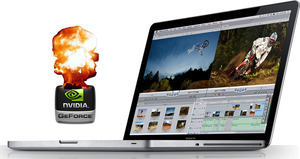Tag: gpu
AMD "Never Settle Forever" GPU bundles will offer you your pick of free PC games
On the face of things, free games bundled in with PC graphics cards seem like great deals, regularly popping in top games alongside the hardware to power them. The problem is, if you're a hardcore PC gamer to begin with,…
Nvidia's GeForce GTX 780 to launch this month? Titan like pricing rumoured
Nvidia's Titan graphics card is a beast of a GPU, not only because of its power, but also thanks to its £800 RRP. And despite only being revealed at the start of the year, it looks as though it's already…
Nvidia 650 Ti Boost graphics card offers solid 1080p performance for under £150
Nvidia are making aggressive moves in the budget end of the PC gaming graphics card market today, introducing the Nvidia 650 Ti Boost card. Less than a week since the unveiling of the rival new AMD HD 7790, it seems…
Nvidia reveal details on future Tegra mobile processors: Logan, Parker
Nvidia have revealed details on what's next in store for their Tegra line of mobile processors. Two new mobile chipsets were teased, going under the superhero codenames Logan (as in X-Men's Wolverine's real name) and Parker (as in Spider-Man alter-ego…
NVIDIA GeForce GTX 660 Ti GPU with Kepler architecture lands with free copy of Borderlands 2
NVIDIA have lifted the lid on their latest GeForce graphics card, the GTX 660 Ti. NVIDIA's cheapest card to include Kepler technology to date, the £249 card lands on 21 September, with some impressive specs for the price. Outperforming last…
REVIEW: Nvidia GeForce GTX 560 Ti
Nvidia's Fermi GPU wagon continues to spout out top-notch cards at low prices, and perhaps none are more appealingly spec'ed and priced than the GTX 560 Ti. It tears into the sub £200 market by some margin if you shop around, but can it compete with the stellar cards AMD are touting at similar price points? Read on to find out.
Nvidia launch "bang-for-your-buck" GeForce GTX 460 GPU
Nvidia are today launching the GeForce GTX 460 GPU. Costing just $199 (£135) for the 768MB version or $229 (£150) for the 1GB card, it boasts mid-range specs at low-end pricing, which should make it a very enticing offer…
Apple and NVIDIA to split?
Apple and NVIDIA may be parting company so soon after the two teamed up. There seems to have been an issue in the renegotiations of the partnership after overheating materials in MacBooks led to failures of the GeForce 8400M and 8600M GPUs. That meant that Jobs Inc had to extend the warranty of their units to three years and that’s not the kind of thing that makes any manufacturer happy.
Apple has apparently described NVIDIA’s attitude as arrogant and if the two can’t work it out then we could see the latter’s chips disappear from iMacs almost immediately and from the rest of the range within three to four years.
Seems a bit of a shame given the level of NVIDIA’s technology and the way that Apple has carved itself a niche at the graphics end of the market but the Cupertino crew has always prided itself on quality of product and, when the chips are down, there’s little choice in the matter.
(via Electronista)
Graphics cards are much better than CPUs at cracking Wi-Fi passwords
There’s a lot of software out there for cracking wireless passwords, and most of it’s legal. Why? Because it’s sold as a way for network administrators to ‘test’ their network’s security. Of course, there’s nothing to stop you ‘testing’ a network that you don’t own, in a coffee shop or airport, for example.
Most cracking programs use your PC’s CPU to do the hardcore number-crunching, but it turns out that the graphics card is actually far better at doing the kinds of calculations necessary. How good? Well, an above average quad-core CPU, the Intel Q6600 can only accomplish 1,100 passwords per second, whereas a similarly above-average ATI HD4870 graphics card can smash through 15,750 passwords per seconds.
Who woulda thunk it? Luckily, we might be seeing some of this power hit regular programs too, with Nvidia’s CUDA, ATI’s Stream, and Apple’s OpenCL frameworks. The graphics card isn’t best at every type of calculation, but if a program can intelligently route calculations to their fastest solver, then we could see blazing program speed increases in the near future.
(via HotHardware)
Related posts: Lightbulbs to replace Wi-Fi? | Another wi-fi detecting thing – this time it’s a SHOE
Intel chip roadmap emerges, "Medfield" and "Pineview" promised
Exciting news from the world of processors! Open the champagne, because the details have turned up about Intel’s forthcoming processors. There’s the “Medfield”, and the “Pineview”, not to be confused with residential homes for the elderly.
The Pineview is expected to be a full “System-on-a-chip”, where all the functions of the PC – the memory controller, I/O, graphics chip, etc, are all on one chip. There are dual-core and single-core versions, and it’ll be built from a 45nm process, just like Intel’s current little champ, the Atom, which powers most netbooks in the market today.
The Medfield will take the same system-on-a-chip approach, but will be built from a 32nm process. It’s expected sometime in 2010, and will be preceded by the Pineview, which is due in 2009. Intel has confirmed that “Medfield” is an Intel codename, but won’t say any more than that.
Intel (via vnunet)
Related posts: Intel’s Xeons: faster, more eco-friendly quad core chips on the loose | Dual core Atom chip in the works at Intel

















